Who is Hamas Blog
The Israel-Hamas War and Regional Relations
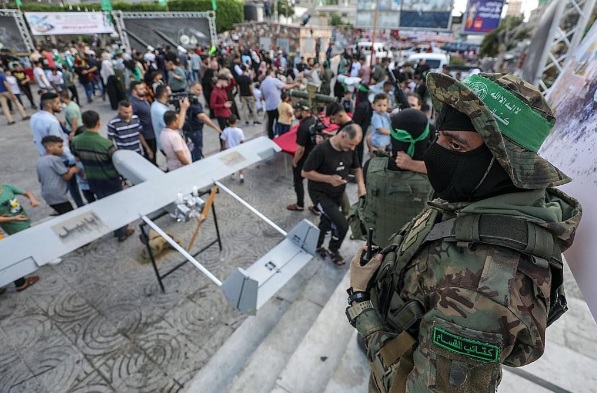
Hamas. Credit: Israel Hayom’s FB page.
The ongoing conflict between Israel and Hamas in the Gaza Strip has far-reaching consequences that extend beyond the immediate theater of war. This the impact of the conflict and the recent Israel Gaza war on regional relations, focusing on the critical aspects of Hamas as a terrorist organization seeking Israel’s destruction and its affiliation with Iran as a proxy.
Hamas: The Terrorist Threat to Israel
At the core of the Israel-Hamas conflict is the undeniable reality that Hamas operates not merely as a political entity but as a bona fide terrorist organization with a clear objective – the destruction of Israel. The group’s recent attacks on Israeli civilians highlight the severity of this threat. Understanding Hamas’s role as a terrorist organization is pivotal in comprehending the gravity of the conflict and its consequences for the entire region.
Hamas and Iran: A Strategic Alliance
Adding another layer of complexity to the conflict is the undeniable connection between Hamas and Iran. As a proxy for Iran, Hamas receives substantial material and financial support, intensifying the threat it poses to Israel. This strategic alliance not only deepens the complexity of the conflict but also raises concerns about broader implications for regional stability. The connection of state-sponsored terrorism and regional dynamics demands attention as the conflict unfolds.
Global Attention Shift: Impact on Ukraine’s Defense
Kiev, Ukraine. Credit: “כאן חדשות” FB page.
Against the backdrop of Russia’s ongoing war on Ukraine, the Israel-Hamas conflict introduces an additional layer of complexity to global geopolitics. Both Ukraine and Russia seek international support, prompting the international community to take positions on the Israel-Hamas conflict. However, the global focus on the war in Gaza threatens to divert attention and resources from Ukraine’s defense efforts. The potential reduction in economic and military assistance poses a direct threat to Ukraine’s ability to defend against external aggression.
Diplomatic Challenges for Ukraine: Navigating Global Alliances
The latest Israel-Hamas war poses diplomatic challenges for Ukraine, which has been actively seeking international support since Russia’s full-scale invasion in February 2022. Ukraine’s efforts encompass garnering military, economic, and humanitarian assistance while condemning and prosecuting the crimes committed by Russian President Vladimir Putin and others. The paralysis of the U.N. Security Council due to Russia’s veto power has pushed Ukraine to rely on the U.N. General Assembly for condemnation of Russian actions. However, the different international responses to the Israel-Hamas conflict jeopardize Ukraine’s long-term diplomatic efforts, potentially undermining its pursuit for global solidarity.
Regional Repercussions: Pressure on Egypt and Jordan Relations
Proximity to the conflict intensifies concerns for countries like Egypt and Jordan. The humanitarian crisis and Israel’s military response raise fears of mass displacement, leading to strained relations. President Abdel Fattah El-Sisi of Egypt rejects settling the issue at the expense of others, emphasizing the need to address the root causes. King Abdullah of Jordan voices concerns over Israel’s displacement of Palestinians, fearing a dangerous precedent that could affect regional stability. The strain on relations with Egypt and Jordan, key players in regional peace efforts, adds an additional layer of complexity to the already intricate web of regional dynamics.
Impact on Israeli-Saudi Normalization: A Setback
Muhamad Bin Salman, Saudi Arabia’s Prince. Credit: “ציוני בנשמה שלי” FB page.
The ongoing conflict disrupts diplomatic efforts towards an Israeli-Saudi normalization agreement. Recent indications of progress in normalization talks have been overshadowed by reports of Saudi Arabia freezing discussions. The Palestinian question, highlighted by the Israel-Hamas conflict, emerges as a central factor influencing Saudi decisions. The disruption in this diplomatic effort poses challenges not only for the immediate peace process but also for broader regional stability.
The Day After: Uncertainties and Consequences
Amid the uncertainty of the ongoing conflict, questions arise about the aftermath. The surprise nature of Hamas’s attack has left Israel less certain about its capacity to engage in a multi-front war. Criticism of Israel’s policies, accused of strengthening Hamas at the expense of the Palestinian Authority, adds a layer of complexity to the aftermath. As the conflict unfolds, the potential diplomatic and military moves of both parties remain unclear, introducing a level of unpredictability to the regional landscape.
In conclusion, the Israel-Hamas conflict echoes across regional relations, interconnecting with global geopolitical dynamics. Recognizing Hamas as a terrorist organization and understanding its ties to Iran is essential for framing an effective response to the multifaceted challenges posed by the ongoing conflict. As regional dynamics evolve, the need for nuanced diplomacy and strategic decision-making becomes increasingly evident to navigate the complex web of regional consequences.
Who is Hamas Blog
Do Gaza civilians work in Israel?
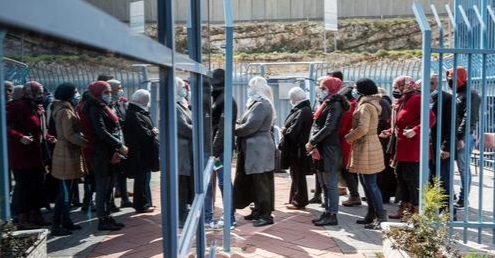
Palestinian workers crossing the border into Israel. Credit: Amiram Brutman’s FB page.
In the tumultuous landscape of the Middle East, the Gaza Strip stands out as a region of particular hardship and complexity. Among the many facets of life in Gaza, the opportunity for civilians to work in Israel has been a topic of significant discussion and controversy. This article delves into the intricate dynamics of Gazan civilians working in Israel over the past few years, exploring its impact on Gaza’s economy, and examining the broader geopolitical implications.
Gazan Workers in Israel: A Recent Overview

Palestinian construction workers in Israel. Credit: ‘Globes English’ FB page.
The history of Gazan workers working in Israel is marked by shifts in policy and circumstance. Following Hamas’ takeover of the Gaza Strip in 2007, Israel largely closed its borders to Gazan workers. However, in recent years, Israel has issued up to 15,500 work permits to Gazans, allowing them to cross into the country for employment. This shift marks a significant development, as these workers are among the first from Gaza to work officially in Israel since 2007.
Economic Effects on Gaza
The return of Gazan workers to Israel has had a notable, albeit limited, impact on the Gaza economy. While individuals can earn substantially more than what’s possible in Gaza, the overall effect on Gaza’s wider economy is minimal, but beneficial for the individual who will be able to fully support his family needs. With a heavily constricted economy under the Israeli-Egyptian blockade, the permits inject about $1 million a day into Gaza’s economy – a small amount given the scale of economic challenges faced by the 2.3 million population of the region.
Work Permits: Leverage and Lifeline
For many Gazans, these work permits are not just about employment; they represent a lifeline for better living conditions. The permits also give Israel a form of leverage over Hamas. For instance, Israel can decide to avoid giving further permits, thus affecting the individual economy of Gaza.
Involvement on October 7t, 2023 Attack Plans
A critical aspect of the discourse around Gazan civilians working in Israel is their alleged involvement in the October 7th attack. Reports indicate that individuals with work permits in Israel gathered information about Israeli cities and settlements in the south, contributing to the planning of this brutal attack. This development highlights a darker side of the work permit system, revealing how it can potentially be exploited for purposes other than economic relief. The incident underscores the complexity of this issue, where the need for employment and economic sustenance in Gaza intersects with security concerns in Israel. It’s a stark reminder of the intricate and often tense relationship between these two, influenced by a history of conflict and the ongoing geopolitical dynamics.
Current State of Work Permits
As of now, after the October 7 attack and the ground entry into Gaza in order to capture all those who were involved in the attack, Israel decided to ban residents of Gaza from entering to work, until further notice. In general, it is safe to say that the situation with work permits for Gaza civilians remains a delicate balance. Israel often describes these permits as goodwill measures. The permits are subject to Israel’s assessment of the security situation, with increase or decrease in the number of permits often linked to the level of calm or tension in the region.
Conclusion
In conclusion, the granting of work permits to Gazan civilians to work in Israel is a multifaceted issue, interwoven with economic necessity, geopolitical leverage, and the pursuit to give a lifeline to Gaza’s residents. While providing a critical source of income for individual Gazan families, the permits also serve as a strategic tool in the complex relationship between Israel and the Gaza Strip. The future of these work permits and their impact on both Gaza’s economy depends on the outcomes of the current “Iron Swords” operation and the ability of the Israelis to feel safe again in their own country.
Who is Hamas Blog
Thai Hostages in the 2023 Israel-Hamas Conflict
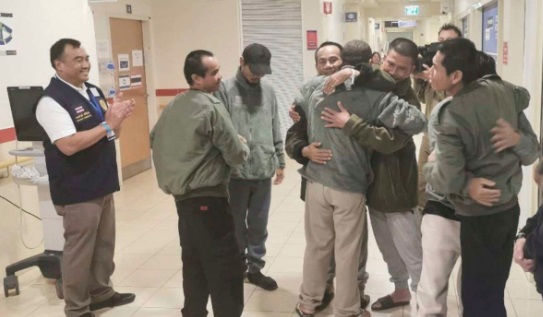
Thai hostages released by Hamas. Credit: ‘Arab News’ FB page.
The 2023 Israel-Hamas conflict witnessed a concerning humanitarian issue: the kidnapping and killing of Thai workers in Israel. This article explores the circumstances surrounding this crisis, providing a detailed analysis for those seeking to understand the broader implications of such conflicts on international labor and security.
The Situation of Thai Workers in Israel
Israel, before the Hamas attack, hosted around 30,000 Thai agricultural workers. The employment of Thais in Israel’s agricultural sector began in the 1990s, following the first Intifada in 1987, which led to a decrease in Palestinian labor due to Israeli movement restrictions. This shift made Thai workers, often working near the Gaza Strip, vulnerable to conflict-related dangers.
During the terror attack of the 7th of October, 2023 by Hamas, 39 Thai workers were tragically killed, and 32 were kidnapped, highlighting the high risk faced by these foreign nationals who choose to work in this area. The crisis underscored the vulnerability of migrant workers in conflict zones.
Conditions of Captivity for Thai Hostages
During their captivity under Hamas, the Thai hostages endured severe and perilous conditions. A released Thai worker revealed that Israeli hostages, held alongside them, were subjected to physical abuse, including beatings with cables. The Thai hostages, as he told them, were first held tied. Only after a few days did they have the option to stand and walk.
The October 7 Attacks
The October 7 attacks was a turning point in the lives of the Thai workers who already witnessed through the years many alarms and rocket attacks. The attacks leading to the death of Thai workers and the capture of over 200 Israeli hostages, by Hamas militants, did not discriminate between locals and foreign nationals, reflecting the indiscriminate nature of such terror. The impact on the Thai workers, far from their homeland and caught in a foreign conflict, was particularly poignant.
Diplomatic Efforts and Humanitarian Response

10 of the freed Thai hostages. Credit: ‘StandWithUs’ FB page.
The release of the Thai hostages was facilitated through diplomatic negotiations and international cooperation, involving various countries and organizations. The return of these hostages brought to light the severe health and psychological challenges they faced, necessitating extensive medical and psychological support. The situation highlighted the need for post-crisis care.
Conclusion
The kidnapping and killing of Thai workers in the 2023 Israel-Hamas conflict brought to the forefront critical issues related to the safety of migrant workers in conflict zones. It underscores the need for international cooperation in crisis resolution and the importance of comprehensive support systems for victims of such crises. The case of the Thai hostages serves as a stark reminder of the broader humanitarian implications of regional conflicts.
Who is Hamas Blog
Has the Red Cross Seen the Hostages in Gaza? – An Insight into the Ongoing Dilemma
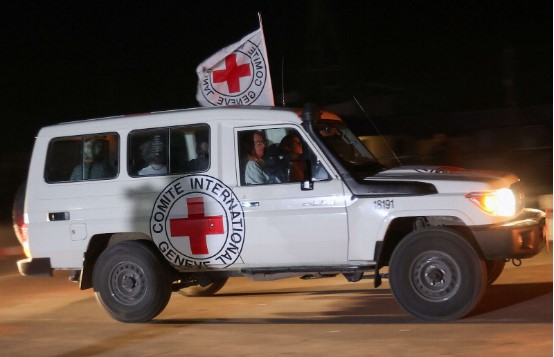
Red Cross vehicle driving Israeli hostages to the Israeli border, when being released. credit: Shay Saig’s FB page.
The situation in Gaza remains tense and complex, especially concerning the hostages held by Hamas since October 7, 2023. The health conditions of these hostages, including 40 infants and children, are unknown, a concern that falls under the purview of the International Committee of the Red Cross (ICRC). This article delves into the intricacies of this issue from multiple perspectives: the Israeli government, the hostages’ families, and the Red Cross.
Israel and US Demands from the Red Cross
The Israeli government has been vocal in its demands for the ICRC to act. Foreign Minister Eli Cohen, after meeting ICRC President Mirjana Spoljaric Egger, emphasized the urgency of the situation. Cohen highlighted the expectation that the Red Cross should prioritize visiting the hostages, assess their conditions, and ensure they receive necessary medical care. Despite taking part in the release and transferring to Israel process of the hostages in November, the ICRC has had no contact with the others, signaling a significant gap in their operations.
The Current Situation: Diverse Perspectives
Israel’s Stance
The Israeli Foreign Minister has stressed that none of the hostages have met with the Red Cross and lamented the lack of proof of life. The demands are not just about visits but also about obtaining information on the hostages’ whereabouts and conditions, especially the wounded and infants. Israel’s expectation is clear: the Red Cross should exert more pressure, including leveraging diplomatic relations to ensure the safety and release of the hostages.
The Hostages’ Families

Israeli hostages’ families. Credit: ACLJ FB page.
The families of hostages, while attending a press conference at the United Nations and also in the Red-Cross committee this month, expressed their agony and the urgent need for action. They demanded justice and the immediate return of their loved ones, underscoring the emotional toll this situation has taken as well as the health toll, as some of their loved ones might suffer from deepened health issues due to lack of treatments and medicines.
Red Cross’s Constraints and Efforts
The ICRC, bound by its need for neutrality and the agreement of conflict parties, faces significant challenges in accessing the hostages. ICRC President Spoljaric has acknowledged these constraints, noting the necessity of safe agreements for any intervention. The organization says, although no news were published regarding those sayings, that it has been advocating for the hostages, including direct contacts with Hamas and influential parties. However, their actions have been critiqued for not being forceful or transparent enough, especially in leveraging international relationships for diplomatic pressure, as well as their incapability of delivering the simple information about the hostages’ condition and if they are getting the treatment needed. Also, it is unclear up until now if the babies that are still hostages, are receiving suitable nutrition and are fed by breastfeeding or baby formula.
Conclusion: Families in the Dark Amidst Limited Red Cross Cooperation
The ongoing crisis in Gaza highlights a severe information void for the families of the hostages, who remain in desperate need of updates about their loved ones. This lack of information is compounded by the Red Cross’s limited cooperation in response to Israeli and US demands. The hostages, caught in the crossfire, continue to be victims not only of the conflict but also of the Red Cross’s constrained ability to provide necessary assistance. Their safety and well-being are increasingly jeopardized due to the absence of adequate medical care and attention, underscoring the urgent need for more effective intervention and communication.
-
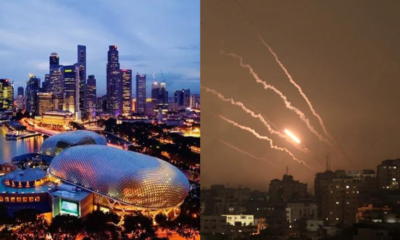
 News3 months ago
News3 months agoGaza could Have Been Singapore. Hamas Turned It Into a living nightmare
-

 News3 months ago
News3 months agoRape, slaughter, and atrocities—see the real face of Hamas
-

 News3 months ago
News3 months agoKidnapping elderly and children: Hamas are no heroes
-

 News3 months ago
News3 months agoShe died while saving lives.
-

 News3 months ago
News3 months agoTrigger warning: This is the atrocity that’s happening in Israel right now
-

 News3 months ago
News3 months agoMonsters: Yahya Sinwar and Hamas kidnapped 150+ children and women.
-

 Hamas War Strategy, Tactics, and PR3 months ago
Hamas War Strategy, Tactics, and PR3 months agoThe War Crimes of Hamas and ISIS in Exploiting Civilians
-

 News3 months ago
News3 months agoHamas turns a music festival into a massacre






